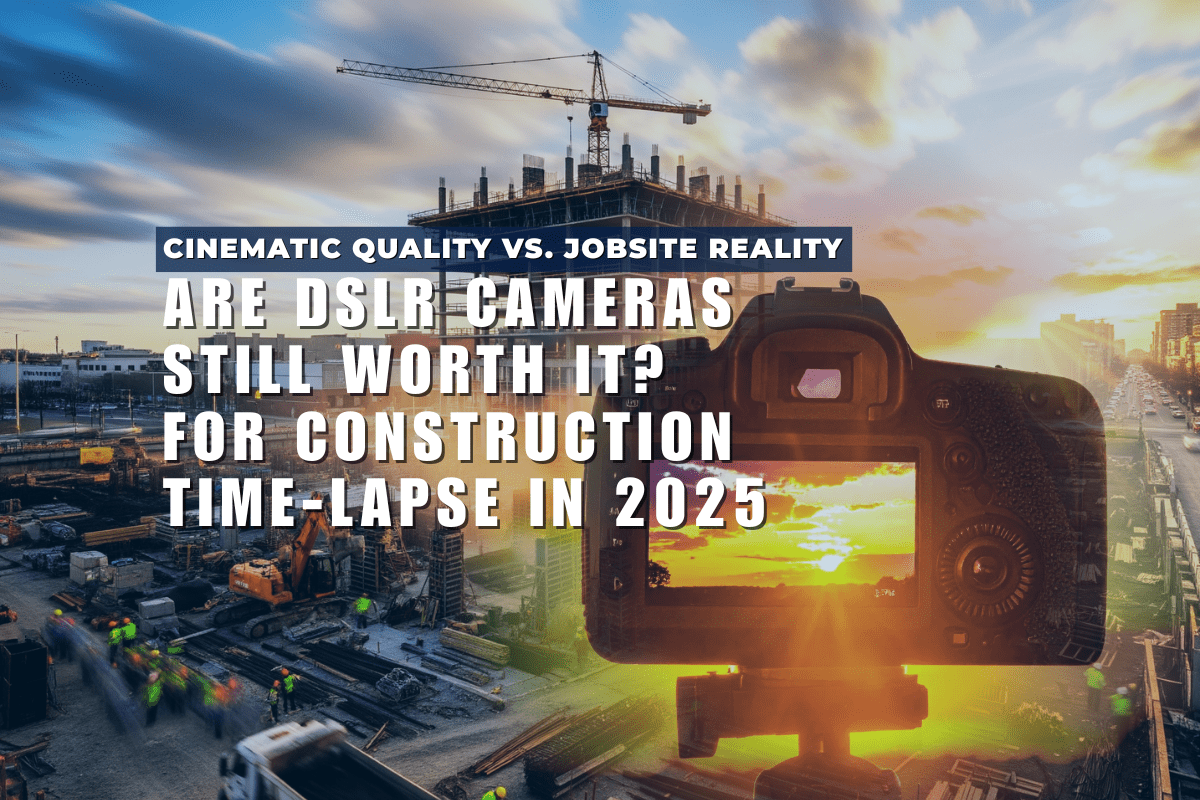Introduction
Time-lapse photography is a fantastic way to document a construction project, promote your work, or keep track of progress over time. When set up correctly, a time-lapse camera can turn months—or even years—of work into a short, captivating video. However, if you don’t configure it properly, you could end up with blurry images, missing frames, or even a complete recording failure.
This guide will walk you through setting up a construction time-lapse camera, avoiding common mistakes, and ensuring the best possible results.
1. Choose the Right Time-Lapse Camera
Not all cameras are designed for long-term outdoor use. Here’s what to consider when choosing one:
✅ Durability – Must be weatherproof and able to handle extreme conditions.
✅ High Resolution – 4K or higher ensures sharp, clear footage.
✅ Power Source – Options include solar, battery, or direct AC power.
✅ Storage Capacity – Needs to last for months without frequent manual maintenance.
✅ Remote Access – Allows you to check and adjust settings from anywhere.
Recommended Cameras:
🔹 SolarUp – Weatherproof, solar-powered, and cloud-enabled for long-term projects.
🔹 PowerUp – Similar to SolarUp but without the solar panel, making it a more budget-friendly option for sites with direct power. 
2. Pick the Best Camera Placement
Where you place the camera will impact the quality of your time-lapse video. Follow these tips:
✔ Get a High & Wide View – Mount the camera high enough to capture the full site.
✔ Ensure a Stable Mount – Use a solid wall mount, pole, or tripod to avoid vibrations.
✔ Check for Obstructions – Make sure trees, buildings, or cranes won’t block the view over time.
✔ Avoid Direct Sunlight – Face the camera north or south to prevent glare.
Pro Tip: Use your site plan, Google Earth, or drone footage to scout the best location before installation.
3. Adjust Camera Settings for Time-Lapse Photography
Recommended Settings:
| Setting | Recommended Value |
|---|---|
| Interval | 30-45 minutes (for long projects) |
| Resolution | 4K or higher |
| Shutter Speed | Auto or 1/500s (for motion clarity) |
| ISO | Auto or Low (100-400) to reduce noise |
| Storage Format | High-quality JPEG |
Why These Settings Matter:
✔ Shorter intervals (e.g., every minute) are best for quick-moving projects.
✔ Longer intervals (30-45 minutes) work well for large-scale projects.
✔ Higher resolution lets you zoom in during editing without losing quality.
4. Ensure Reliable Power & Storage
Power Options:
🔋 Battery-Powered – Best for short-term projects.
🔆 Solar-Powered – Great for long-term outdoor setups.
🔌 Wired Power – The most reliable but requires proper installation.
Pro Tip: Use an uninterruptible power supply (UPS) as a backup in case of power failure.
Storage Options:
📁 SD Cards (Short-Term Use) – Use high-speed 128GB+ cards.
☁ Cloud Storage (Remote Monitoring) – Services like CamDo CloudX.
💾 External Hard Drives (For Backups) – Keep raw footage safe for long-term storage.
5. Protect Your Camera from Weather & Theft
Weatherproofing Tips:
✔ Use a weatherproof case to shield against rain, snow, and dust.
✔ Apply anti-fog spray to the lens to prevent condensation.
Security Measures:
✔ Install in a hard-to-reach location to deter theft or tampering.
✔ Use a steel security box and anti-theft cable locks.
✔ Enable remote monitoring to check the camera’s status online.
6. Monitor & Maintain Your Setup
Routine Maintenance Checklist:
✔ Clean the lens weekly – Use a microfiber cloth for clear images.
✔ Check the power supply – Replace batteries if needed.
✔ Monitor storage space – Avoid losing footage due to full memory.
✔ Backup footage weekly – Prevent accidental data loss.
Pro Tip: Set up automated alerts to notify you if the camera stops recording.
7. Edit & Compile Your Construction Time-Lapse Video
Editing Tips:
✔ Use software like LRTimelapse, Adobe Premiere Pro, or CamDo UpBlink.
✔ Adjust the frame rate to 24-30 FPS for smooth playback.
✔ Add motion effects (panning & zooming) for a professional touch.
✔ Include branding, timestamps, and project details in the final video.
Frequently Asked Questions (FAQs)
Q1: What’s the best time-lapse interval for construction projects?
A: For projects lasting a year or more, a 30-45 minute interval is ideal. Use a time-lapse calculator to plan your settings.
Q2: Can I use a GoPro for construction time-lapse?
A: Yes, but GoPros require external power and weatherproof cases for long-term use. CamDo accessories can help with this.
Q3: How do I prevent flickering in time-lapse videos?
A: Use manual exposure settings and consistent lighting. Software like LRTimelapse can help fix flickering in post-production.
Q4: What happens if my camera loses power?
A: A solar panel setup is the best solution for uninterrupted recording.
Q5: What’s the ideal length for a time-lapse video?
A:
📅 1-year project → 1-minute video
📅 6-month project → 30-second video
📅 2+ years → Keep it under 90 seconds for better engagement.
Conclusion
By choosing the right camera, fine-tuning your settings, ensuring reliable power, and keeping up with maintenance, you can create a high-quality construction time-lapse video that showcases your project beautifully.
Need expert time-lapse solutions? Check out CamDo’s industry-leading time-lapse products!



